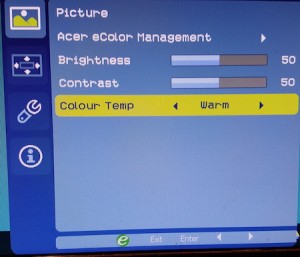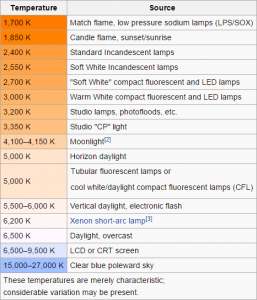The term color temperature is a good one to know. It helps describe something you probably are aware of but otherwise can’t figure out. And it has nothing to do with how fast crayons can melt.
For your computer, the term color temperature plays a role in one of the more obscure monitor settings. Somewhere on that secret monitor menu you access accidentally, you see an option that says Color Temp. You may see simple options, such as Warm (as opposed to Cool) in Figure 1, or you might see values, such as 3500K or 9000K.

Figure 1. Color temperature settings on my (obviously British) monitor.
The K value is the actual color temperature in Kelvin. The specifics are dull, but what’s important is that the higher the K number the more blue — and cold — the light appears to human eyes. Lower values appear warm, more yellow and red. Here’s a color temperature chart I stole from the color temperature entry on Wikipedia:
Color temperature also plays a role in photography. Smarter cameras can adjust the temperature before you snap the image, yet most professional photographers adjust the temperature when photo-editing. This task is necessary because human eyes are terrible at guessing color temperature.
For example, the standard fluorescent lights you find in a school, office, or public building have a color temperature range of 4000K to 5000K. When you take unfiltered photos under such lights, everything appears green. Your eyes don’t detect that color, but the camera does.
Finally, color temperature plays a role when you consider the common light bulb. And, of course, light bulbs are anything but common today.
The traditional, incandescent bulb has a warm temperature, typically about 2800K or 3000K. When you replace one with a CFL or LED bulb, it helps to keep the light output in that same, warm temperature range. Otherwise you end up with the harsh output of a cold color light, such as the 9000K bulb I purchased which looked just hideous in my kitchen. It made my sink look like the operating table in a morgue.
I’m not a mad environmentalist, but I value saving energy. My office currently uses 65W incandescent flood lights, which show a nice warm color. I tried replacing them with CFL lamps, but the result was this ugly, cold color that I found irritating.
Recently, I purchased some warm LED lamps. I wanted to see if the color would be fine as well as the illumination. The results are wonderful, with the LED lamps not only looking warm but also being as bright as the old incandescents.
Those old lamps ran hot, burned out after a few months, and were rated at 65 watts. The new LED lamps run cool, as supposed to last for 26 years, and are rated at 7 watts.



I worked for a monitor company, the colour temperature is the temperature of the filament glowing (Yes even LEDs have a ‘filament’) if you go digging you can find the temperature of the light source you are using and set the colour temp to the closest to it and blacks look black, whites look white. If as you say you replaced your Incandescent flood lights with CL, did you alter the colour temp on you your monitor to match? Even if the lights looked rotten your PC would look normal!
Comment by glennp — October 30, 2015 @ 6:57 am
To answer your question: No. The monitors look fine. I kept one incandescent so as to visually judge the difference between it and the newer LEDs. I could see no difference, not even on white paper.
I recall changing a monitor’s temperature only once. The display bugged me and I thought it was the background. After messing around, I reset the color temperature to “warm” or whatever and I thought it looked great. I know fussy graphic artists (are there any other kind?) mess with monitor temperature all the time.
Comment by admin — October 30, 2015 @ 7:24 am